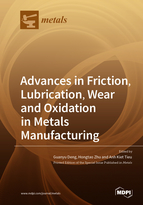Advances in Friction, Lubrication, Wear and Oxidation in Metals Manufacturing
A special issue of Metals (ISSN 2075-4701).
Deadline for manuscript submissions: closed (31 December 2021) | Viewed by 26661
Special Issue Editors
Interests: high entropy alloys; titanium alloys; advanced manufacturing; severe plastic deformation; computational modelling; contact mechanics; oxidation and tribology; texture and residual stress
Special Issues, Collections and Topics in MDPI journals
Interests: metal forming; tribology and lubrication; contact mechanics; rolling contact fatigue; fracture control; oxidation mechanics; quantum and molecular dynamic simulation
Interests: metal and alloys; rolling technology; mechanics of materials; computational materials science; multiscale modelling; severe plastic deformation; tribology in manufacturing process; friction and wear analysis; novel lubricants; oxidation and corrosion of materials
Special Issues, Collections and Topics in MDPI journals
Special Issue Information
Dear Colleagues,
In recent years, metals manufacturing has been undergoing significant transformation through optimizations of conventional manufacturing methods and systems (rolling, forging, welding, etc.) and through the promotion of new manufacturing processes and techniques (e.g., additive manufacturing and nanomanufacturing), due to the emergence of new materials such as high-entropy alloys and the growing requirement of manufacturing efficiency and product quality. Simultaneously, tribology, which plays an important role in metals manufacturing, has attracted increasing attention and interest in both the industrial and academic communities. With the development of both experimental techniques and computer simulation methods, the origin of friction, principles of lubrication, the performance of lubricants, mechanisms of wear, and the oxidation of metals and alloys during the manufacturing processes have become assessable at different length and time scales.
We would like to invite researchers to submit original research papers, short communications, and review articles to this Special Issue on “Advances in Friction, Lubrication, Wear and Oxidation in Metals Manufacturing”. This Special Issue is dedicated to disseminating the latest research and understandings based on advanced experimental studies and computational modellings related to the development of novel lubricants for the manufacturing and characterization of tribological properties and oxidation behavior of metals. The potential scope of interest includes (but is not limited to):
- Advanced manufacturing;
- Metal forming;
- Metals and alloys;
- Development and application of novel lubricants;
- Tribology testing;
- Characterization of friction and wear;
- Oxidation in manufacturing;
- Contact mechanics, computational simulation, and multiscale modeling.
Dr. Guanyu Deng
Dr. Hongtao Zhu
Prof. Anh Kiet Tieu
Guest Editors
Manuscript Submission Information
Manuscripts should be submitted online at www.mdpi.com by registering and logging in to this website. Once you are registered, click here to go to the submission form. Manuscripts can be submitted until the deadline. All submissions that pass pre-check are peer-reviewed. Accepted papers will be published continuously in the journal (as soon as accepted) and will be listed together on the special issue website. Research articles, review articles as well as short communications are invited. For planned papers, a title and short abstract (about 100 words) can be sent to the Editorial Office for announcement on this website.
Submitted manuscripts should not have been published previously, nor be under consideration for publication elsewhere (except conference proceedings papers). All manuscripts are thoroughly refereed through a single-blind peer-review process. A guide for authors and other relevant information for submission of manuscripts is available on the Instructions for Authors page. Metals is an international peer-reviewed open access monthly journal published by MDPI.
Please visit the Instructions for Authors page before submitting a manuscript. The Article Processing Charge (APC) for publication in this open access journal is 2600 CHF (Swiss Francs). Submitted papers should be well formatted and use good English. Authors may use MDPI's English editing service prior to publication or during author revisions.
Keywords
- Manufacturing
- Metal forming
- Metals and alloys
- Tribology
- Lubricants and lubrication
- Friction and wear
- Oxidation
- Simulation and modeling








